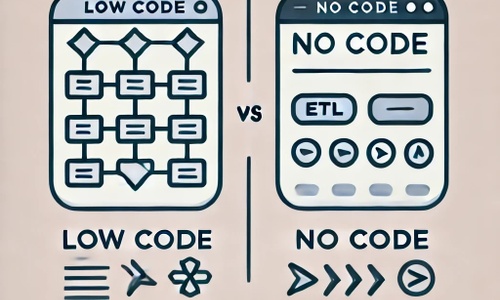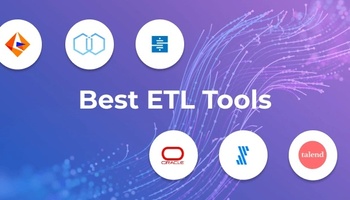If someone was stranded at sea, what do you think they would first want when they are finally rescued? Drinking water. Isn't that ironic? Even though they were surrounded by water, it was not CONSUMABLE, and the situation is true for a lot of organizations. You have a lot of data, but it’s not consumable.
Ramkumar Nottath, the Senior Solutions Architect at AWS, beautifully puts it. And that’s where low-code or no-code ETL platforms can help—to make the data consumable and democratize it. In this blog, I explain low-code vs. no-code from my experience.
Key takeaways
- Hands-on explanation of no-code vs low-code ETL
- Clear understanding of when to choose no-code or low-code ETL
Next, I’m going to dig a little deeper into what Ramkumar said and start from where exactly low-code and no-code comes into picture.
What’s the big deal with Low-code and No-code?
Let’s take one scenario.
There are a lot of data teams who still rely on the legacy tools for data integration. The problem is they lock in business transformations logic into proprietary code, inhibiting you to migrate into innovative technologies. The data engineers wait for infrastructure to be made available or are part of installation configuration instead of focusing on business problems.
They have to learn multiple tools- one for stream processing and another for batch processing, and even a third one for event processing which makes it hard with contact switching. The main issue with the legacy tools is the technical level required to use them and the time it takes to make changes / maintain infra / push updates / etc.
Now, how’s a low-code platform solve the problem?
Low code and no-code ETL platforms are revolutionary tools in the ETL landscape. Low code platforms enable developers to build pipelines with minimal hand-coding by using visual development tools. No-code platforms go a step further by allowing non-developers to create pipelines using intuitive drag-and-drop interfaces.
We have taken only one case. Another case is, you have an in-house data pipeline set up, but data preparations and cleaning takes a lot of time and effort from the team. This could also end up in a lot of manual errors.
Understanding Low-code ETL Platforms
As per Microsoft Low-code Trend Report 2022, 81% say that low-code has led to closer collaboration. The user-friendly user interface plays a big role here.
Hands down, the impact made by low-code development platforms for better customer experience are massive!
Now, coming to definition- low-code ETL platforms enable a rapid pipeline generation and management technique or approach having model-driven logic, and integration capabilities. Here, you can actually have access to the normal visual tools, point click, drag and drop, to perform your business needs through friendly UIs that prioritize user experience. But, also use the programming languages and your the coding skills or scripting to augment what you are doing.
If I have to draw an analogy, it’s kind of like the BI tools. Tableau allows you to create dashboards by dragging and dropping fields onto a canvas. Now, imagine using a more advanced data visualization tool like Power BI, where you can still drag and drop to create visuals, but you also have the option to write DAX formulas or connect to custom APIs for more complex data manipulations. So low code is kind of like the best of both worlds that you are able to achieve.
Who would be benefiting from this?
This is for developers who want to build with code, also for business technologists like data analysts.
Next, let me take an example of a low-code ETL platform for better demonstrating low-code vs no-code for you.
Low code platform transformation UI
The image shows the transformation console of integrate.io’s platform which is a true low code (yes, some low-code tools require sufficient coding knowledge, but are categorized under low code. Therefore, the term). We will come to that later.
As you can see in the figure, it provides pre-built templates for all types of modifications you want to make in your data before sending that to a target. Data cleaning by formatting the data types, redundant records, or hashing for masking sensitive data– all can be done just by selecting the option.
Now, let’s weigh the pros and cons.
|
Benefits of low-code ETL |
Limitations of low-code ETL |
|
Accelerates traditional development timelines, allowing for quicker pipeline creation and working with business applications |
May still be too complex for users without a technical background |
|
Offers a higher degree of customization compared to no-code platforms, making it suitable for more complex applications |
Faster pipeline management can lead to accumulated technical debt if not managed properly |
|
Reduces the need for extensive coding with development time, lowering overall costs for the project |
That’s about low-code ETL. What about no-code? Does that mean literally no-code at all?? Let’s dive right into it to understand.
Understanding No-code ETL Platforms
The capabilities of a no code ETL platform is what you see is what you get to interact with, where you point and click, drag and drop and it’s done! The pre-built modules will do the entire job for you. Such tools are a fully visual tool. There is no opportunity to actually do any coding at all.
In the broader definition in app development, a no code platform helps you build other development process automations that are there to do decision authoring, like with business rules or maybe some document processing, but then be able to build the integration type technologies in the background that really facilitate a lot of interaction between applications.
When it comes to ETL, this means it gives you the flexibility to write your code for any sort of transformations, data ingestion, loading to the destination, pipeline management etc. This depends on the features offered by the tool.
So, who are those no-code development platforms built for?
Professional developers , seasoned technologists, and citizen developers who have come across ETL projects and you want to execute. But also open up the world to a whole new class of technologists. In short, you can be as non technical as you want to use no-code solutions and maybe have a little bit of coding experience.
|
Benefits of no-code ETL |
Limitations of no-code ETL |
|
Enables business users and other non-developers to carry out data integration without needing to learn to code. |
May not offer the level of customization needed for complex applications. |
|
Facilitates quick creation and management of data pipelines, ideal for testing ideas. |
Simplified replication processes can sometimes lead to data pipeline security and compliance oversights. |
|
This approach democratizes data replication, making it accessible to a wider range of users. |
Low-code vs No-code Platforms; Drawing the parallel
|
Parameter |
Low-code ETL |
No-code ETL |
|
Companies |
Enterprise level |
Small businesses |
|
Visual |
Yes |
Yes |
|
code/scripting for data modifications |
Yes |
No |
|
Who can use it? |
Professional dev, power users, citizen devs |
business users and non-developers |
|
Learning curve |
Steeper learning curve due to its complexity |
Easier to learn and use |
|
Cost (in general) |
Cost greater than no-code |
Cost effective |
|
Example from data industry |
Integrate.io |
Zapier |
Low code and no-code- code collaboration - low-code people working on a project. when some components of the application can be done in no-code.
Low-code vs No-code vs High Code Platforms
As mentioned before, when a tool is labelled under low code, the extent to which it allows coding is not defined. And this makes a whole difference in use cases. For example, if your use case is to sum up sales data across multiple dimensions (by region, product, and time period) while applying conditional logic, such as only including sales above a certain threshold or excluding specific regions.
This will get complex depending on the data volume and the conditions you apply. When a platform is truly low code, it will provide you the templates for the transformation like integrate.io. But, when it’s not truly low code, it will still have the functionality for doing the transformation in-flight, but the extent of coding will be more. Some examples are Rivery, which is SQL based and Matillion which is Python based.
Does the Future of Low-code and No-code Replace Developers?
That’s not an easy question. A lot of automations will be there as part of digital transformation, definitely! But, the right way to look at that would be that– developers can focus to streamline other problems relevant to business. Low code and no code ETL tools will help with the automation of the integration processes. The innovations introduced by Snowflake are promising and, we can expect such path breaking advancements using machine learning and artificial intelligence in future from other leading companies in the data industry. You will need to keep up with the emerging technologies and learn to adapt to the changes and be the one to be able to use them faster.
Conclusion
In this blog, we learned no code vs low code ETL platforms and different parameters to consider before opting them. And, there are always confusions on which tools in the industry are truly low code. Having a clear understanding of the pre-built components offered for data preparation and cleaning will help to understand this.
Also, there is a fuss about low code and no code going to take over the development sector including ETL. While the advancements are promising, I feel that the worry should be whether we are able to keep up with the skills demanded for the technologies.











